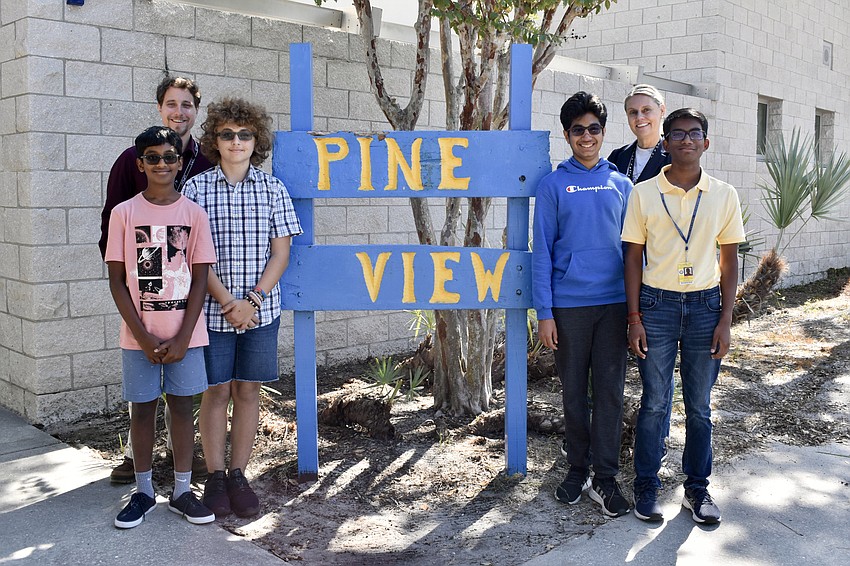- July 26, 2024
-
-
Loading

Loading

After four middle school students from Pine View School finished assembling their science experiment, they packaged it according to the correct protocols and sent it to Houston, Texas, for a toxicology report.
The report ensured that the materials inside would not harm the astronauts who will be handling it aboard the International Space Station (ISS).
“Something that we touched is actually going to be flying in space,” said Rugan Suresh.
The team of seventh graders (now eighth graders), which also includes Yatharth Kakkad, Felix Ratner and Rishik Yellu and is led by teacher facilitator Marie Rosander, was among 39 selected, out of 2,261 in 37 communities among the United States; Edmonton, Canada and Ukraine, and from 350 students at Pine View School, for the Spaceflight Experiment Program.

The team will help test the ability of a microalga, chlorella vulgaris, to treat wastewater in a microgravity environment like the one found on the ISS.
But according to Dylan Bell, a science teacher at Pine View, there’s more.
“As soon as it comes back, you'll see the implications for years to come, with the amount of research papers that you guys produced, the people who cite you,” he told the students. “You’ll see what you have been implementing in the scientific community.”
After the four students began participating in the program, they started to learn more about microalgae and its wastewater treatment applications on earth.
That includes learning about chlorella vulgaris, a microalgae strain that can grow without sunlight, using organic carbon and wastewater.
“It's a really innovative new tool that's being researched at the moment. We still don't know its full extent, or the possibilities of the field,” said Yatharth Kakkad.
The students' hypothesis is that the microalga will remove nitrogen and phosphorous from water in microgravity, to the same extent it does on earth or even more effectively. They hope it will result in an additional feature that could enhance the water purification process in space.
In microgravity, forces act differently on a microscopic scale, said Bell. The biggest hindrance could be changes to the buoyancy of the microalgae that would decrease the amount of nutrients it comes into contact with, he said.
“Maybe it grows better there. Maybe it takes less energy to move nutrients around, or maybe it’s a hindrance,” said Ratner.
The setup will clearly account for the differences, however.
At the same time that astronauts pull a clamp in a tube to release the algae into synthetic urine, the students will do likewise with their own copy of the setup they also have assembled. The astronauts will share their data with the students through an experiment log.
After two weeks, when the experiment ends, both parties will pull another clamp, releasing a fixative that kills the algae, and the equipment will be returned to earth, allowing the students to compare the results.

Although the laboratory work involved in the project is beyond what the school's facilities were able to accommodate, the team reached out to scientists at the University of South Florida, who gave the students guidance and the use of their laboratory.
The next step is for the group to visit Kennedy Space Center for the launch, which is currently planned for Nov. 7, with a group of 25 people including families, teachers and stakeholders. There, the students will also give a presentation on the experiment.
The experiment will be shipped to the ISS on the 19th flight opportunity (Mission 17) of the SSEP, on the rocket SpaceX CRS-29.
For Rosander, it’s already a mission accomplished.
“This is just amazing that we have this opportunity and we can do this,” she said.
Addressing the students, she says, ”Your curiosity has been sparked; you can go out in life and do amazing things.”
The students agree that it's a chance not often found, especially for middle school students.
“It’s very cool,” said Yellu. “This is not a very common opportunity for multiple people, but we had this chance, and it just it just feels right; it feels really good, and we all like science here.”
“Truly, it's incredible that we've been given this opportunity here at Pine View… It’s the opportunity of a lifetime, honestly,” said Kakkad.
Ratner hopes the possibilities won't end with the mission.
“Besides sending it up into space, once it comes down it might have real world impacts, and might actually help astronauts go to maybe Mars or further, and it still has applications here on earth, of course," he said. "I'd love to do more research into it."
Correction: This article has been updated to correct the name of Dylan Bell.